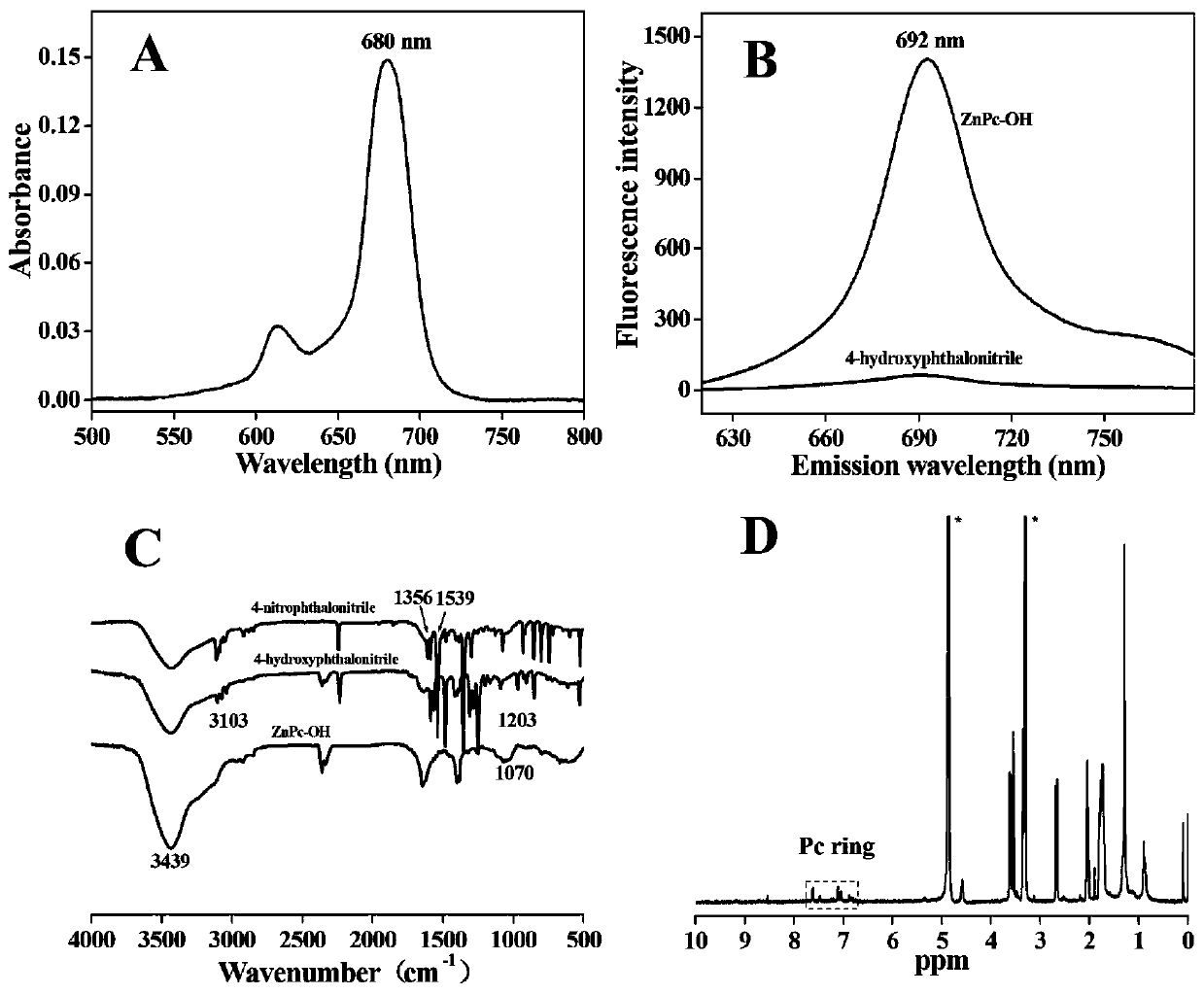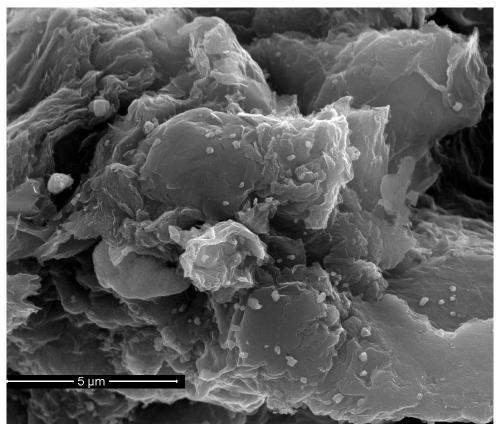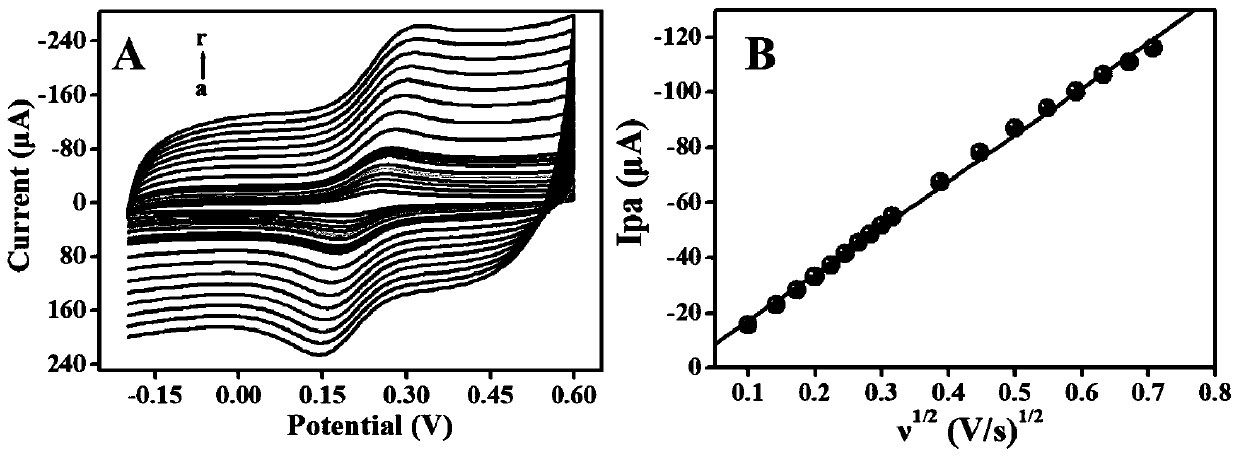Tetrahydroxy phthalocyanine zinc-reduced graphene oxide nano-composite as well as electrochemical sensor prepared from the same and application thereof
A nanocomposite, zinc hydroxyphthalocyanine technology, applied in the field of electrochemistry and nanomaterials, to achieve good conductivity, good reproducibility, and improved dispersion
- Summary
- Abstract
- Description
- Claims
- Application Information
AI Technical Summary
Problems solved by technology
Method used
Image
Examples
Embodiment 1
[0034] Example 1: Preparation of zinc tetrahydroxyphthalocyanine-reduced graphene oxide nanocomposite
[0035] (1) Preparation of 4-hydroxyphthalonitrile:
[0036] Weigh 0.1mol 4-nitrophthalonitrile, 0.1mol sodium nitrite and 0.1mol anhydrous potassium carbonate in a round bottom flask, add 40mL N,N-dimethylformamide (DMF) to dissolve, and Nitrogen was introduced for 1 h while stirring, and under the protection of nitrogen, it was placed on a constant temperature magnetic stirrer and heated to 120 ° C for 24 h. After the reaction was completed, it was cooled to room temperature, and then filtered under reduced pressure. At this time, the solution was reddish orange, and then poured into the filtrate Add concentrated hydrochloric acid to the solution, adjust the pH to between 2-3, seal the filtrate and place it at 4°C for 2-3 days, a large number of flocculent precipitates appear in the solution, filter under reduced pressure, and wash the precipitate with water to neutral , d...
Embodiment 2
[0041] Example 2: Characterization of zinc tetrahydroxyphthalocyanine
[0042] The prepared zinc tetrahydroxyphthalocyanine was characterized by ultraviolet absorption spectrum, fluorescence spectrum, infrared spectrum and hydrogen nuclear magnetic resonance spectrum. The results are as follows: figure 1 shown. From the UV absorption spectrum, it can be seen that ( figure 1 A), the characteristic absorption peak of phthalocyanine appeared at 680nm, and the fluorescence spectrum shows ( figure 1 B), 4-hydroxyphthalonitrile has no fluorescence emission peak, while tetrahydroxyphthalocyanine zinc has a typical fluorescence emission peak of phthalocyanine ring at 692nm, indicating that a complete phthalocyanine ring is formed. It can be seen from the infrared spectrum that ( figure 1 C), in the infrared spectrum of 4-nitrophthalonitrile (4-nitrophthalonitrile), at 1539cm -1 and 1356cm -1 There are two stretching vibration peaks of nitro, in 4-hydroxyphthalonitrile (4-hydroxyp...
Embodiment 3
[0043] Embodiment 3: the preparation of electrochemical sensor
[0044] (1) Glassy carbon electrode pretreatment: using 0.3 and 0.05 μM Al respectively 2 o 3 Polished glassy carbon electrode (GCE), ultrasonically cleaned with absolute ethanol and ultrapure water in turn, and dried at room temperature for later use;
[0045] (2) Mix the ZnPc-rGO nanocomposite solution with a 0.5% Nafion solution (Nafion D-520 dispersion) at a volume ratio of 1:1, and apply 5 μL of the mixed solution onto the surface of the pretreated glassy carbon electrode. Dry at room temperature to obtain a ZnPc-rGO nanocomposite modified glassy carbon electrode, which is the ZnPc-rGO electrochemical sensor prepared in the present invention.
PUM
 Login to View More
Login to View More Abstract
Description
Claims
Application Information
 Login to View More
Login to View More - R&D
- Intellectual Property
- Life Sciences
- Materials
- Tech Scout
- Unparalleled Data Quality
- Higher Quality Content
- 60% Fewer Hallucinations
Browse by: Latest US Patents, China's latest patents, Technical Efficacy Thesaurus, Application Domain, Technology Topic, Popular Technical Reports.
© 2025 PatSnap. All rights reserved.Legal|Privacy policy|Modern Slavery Act Transparency Statement|Sitemap|About US| Contact US: help@patsnap.com



